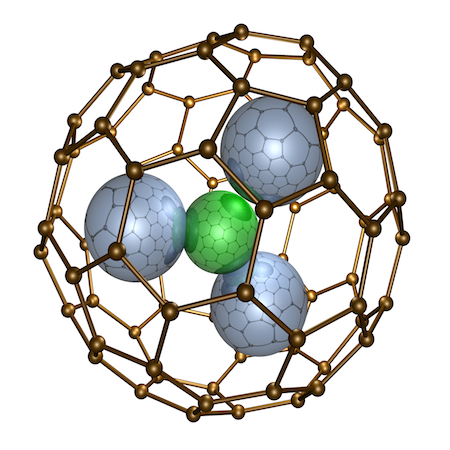Spin Shuttles

The project "Spin shuttles" investigates molecules with unpaired electron spins in view of their performance in
molecular spintronics.
Spin shuttle is a term coined for endofullerene molecules that encage and protect an atom or molecule with an open electron shell.
Such molecules are candidates for single molecule magnets and have a great potential as building blocks in molecular spintronics.
A single molecule magnet is a single molecule that retains its magnetization direction for a long period of time, i.e. displays hysteresis.
The first single molecule magnet spin shuttle was Dy2ScN@C80.
Our experiments cover magnetic characterization of the electronic ground state with magnetometry and x-ray circular dichroism (XMCD).
The structure of the molecules on surfaces is investigated by x-ray photoelectron diffraction (XPD),
also with resonant excitation (RXPD) and tunneling microscopy (STM) and spectroscopy (STS).
In collaboration with Dr. Matthias Muntwiler and Dr. Cinthia Piamontheze, PSI Villigen and Dr. Alexey Popov, IFW Dresden.
Team
- Prof. em. Thomas Greber
- Wei Chuang Lee
Latest publications
- Quantum Tunneling of the Magnetization in Systems with Anisotropic 4f Ion Pairs: Rates from Low-Temperature Zero-Field Relaxation
ACS Omega, 9, 37183 (2024)
→ DOI: 10.1021/acsomega.4c04388 - Monolayer calibration of endofullerenes with x-ray absorption from implanted keV ion doses
J. Vac. Sci. Technol. A 42, 023406 (2024)
→ DOI: 10.1116/6.0003302 - Correlation of Work Function and Conformation of C80 Endofullerenes on h-BN/Ni(111)
Adv. Mater. Interfaces 2300935 (2023)
→ DOI: 10.1002/admi.202300935 - Inferring the Dy-N axis orientation in adsorbed DySc2N@C80 endofullerenes by linearly polarized x-ray absorption spectroscopy
Phys. Rev. Materials, 7 086001 (2023)
→ DOI: 10.1103/PhysRevMaterials.7.086001 - X-ray absorption measurements at a bending magnet beamline with an Everhart-Thornley detector: A monolayer of Ho3N@C80 on graphene
J. Vac. Sci. Technol. A 40, 053205 (2022)
→ DOI: 10.1116/6.0001961 - ...[→ more publications]


